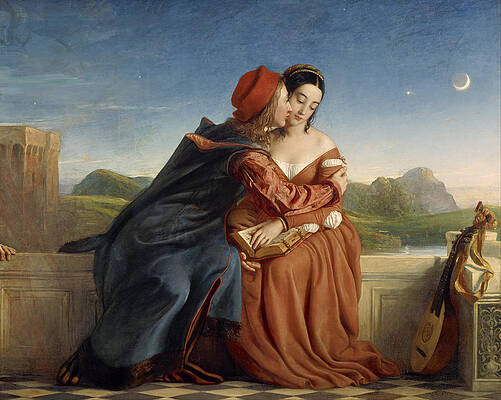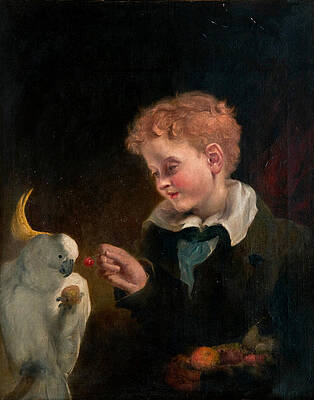William Dyce
Paintings
The Meeting of Jacob and Rachel
Francesca da Rimini
Pegwell Bay Kent
A Boy and his Parrot
Piety The Knights of the Round Table about to Depart in Quest of the Holy Grail
Eliezer of Damascus
Glen Rosa, Isle of Arran
Welsh Landscape with two Women knitting



Pegwell Bay, Kent a Recollection of October 5th 1858

Titian Preparing to Make His First Essay in Colouring

The Virgin and ChildWelsh Landscape with Two Women Knitting



A decorative design, possibly for a fabric or wallpaper,



A mother and child, probably the Virgin and Child




Bacchus Nursed by the Nymphs of Nyssa

Bacchus nursed by the Nymphs of Nyssa




Christ by the Well - Sketch for 'The Woman of Samaria'











The Meeting of Jacob and Rachel








Isabella Cay (also known as The Artist's Sister)


Joash Shooting The Arrow Of Deliverance

Henry VI at Towton, North Yorkshire

King Lear and the Fool in the Storm



The Lamentation of the Dead Christ





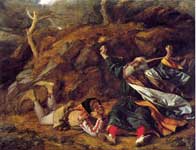
King Lear and the Fool in the Storm
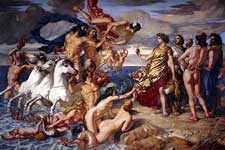
Neptune Resigning To Britannia The Empire Of The Sea
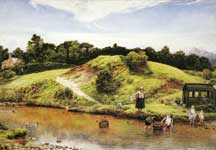
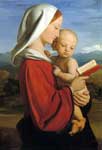
Fine Art Prints | Greeting Cards | Phone Cases | Lifestyle | Face Masks | Men's , Women' Apparel | Home Decor | jigsaw puzzles | Notebooks | Tapestries | ...
Francesca da Rimini
William Dyce FRSE RSA RA (/daɪs/; Aberdeen 19 September 1806 – 14 February 1864) was a distinguished Scottish artist, who played a significant part in the formation of public art education in the United Kingdom, as perhaps the true parent of the South Kensington Schools system. Dyce began his career at the Royal Academy schools, and then travelled to Rome for the first time in 1825. While he was there, he studied the works of Titian and Poussin. He returned toRome in 1827, this time staying for a year and a half, and during this period he appears to have made the acquaintance of the German Nazarene painter Friedrich Overbeck. After these travels, he settled for several years in Edinburgh. He supported himself by painting portraits at first, but soon took to other subjects of art, especially the religious subjects he preferred.
He was given charge of the School of Design in Edinburgh, and was then invited to London, where he was based thereafter, to head the newly established Government School of Design, later to become the Royal College of Art. Before taking up this post in 1838 he and a colleague were sent to visit France and Germany to enquire into design education there and prepare a report. He left the school in 1843, to be able to paint more, but remained a member of the Council of the school.[1] The ideas that were turned in the following decade into the "South Kensington system" that dominated English art education for the rest of the century really have their origin in Dyce's work.
His most highly thought of painting today is his exceptionally detailed seaside landscape of Pegwell Bay in Kent, now in the Tate Gallery. A rather atypical work, it is fully titled Pegwell Bay, Kent – a Recollection of October 5th 1858, and was exhibited at the Royal Academy summer exhibition in 1860.[2]
He was also interested in music, especially church music, playing the organ and composing works that outlasted him.

William Dyce
The largest collection of William Dyce's work is held at Aberdeen Art Gallery, Scotland.
Westminster frescoes
St Joseph by William Dyce (1806–1864)
The Return of King Arthur
Knights of the Round Table Departing on the Quest for the Holy Grail
Later in his career, Dyce turned to fresco-painting, and was selected to execute a series of murals at the newly completed the Palace of Westminster.[3] In preparation for work at Westminster, he returned to Italy in 1845–47, to observe the fresco techniques employed there. He was particularly impressed by Pinturicchio's frescoes in the Piccolomini Library in Siena, and by the works of Perugino.
Dyce was commissioned to decorate the Queen's Robing Room in the Palace. He chose as his subject the Arthurian legends,[4] He had some difficulty adapting the Courtly love of Malory's tales to Victorian mores. The Arthurian legend became popular later in the Victorian period, but when Dyce received the commission to decorate the room in 1847, it was still an obscure subject. The legend soon became a major problem for Dyce, as it turns on the unfaithfulness of a queen, which causes the fall of a kingdom.
After initially experimenting with a narrative sequence in which the tale would unfold in the room's panels, Dyce abandoned this in favour of an allegorical approach. In their finished form, Dyce's frescoes depict scenes from the Arthurian legend that are intended to exemplify the virtues inscribed beneath them. The actions of the figures in his frescoes appear to the modern viewer to convey qualities whose status as virtues is uncertain, and the connection between the episodes from the Arthurian legend and the virtues they represent is sometimes difficult to discern. The virtues depicted are Mercy, Hospitality, Generosity, Religion, and Courtesy. Two projected frescoes, Courage and Fidelity, were never executed.
He was working on the frescoes in Westminster when he collapsed, and later died at his home in Streatham on 14 February 1864. He was buried at St Leonard's Church, Streatham. A nearby drinking fountain, designed in the neo-Gothic style by Dyce, was subsequently dedicated to him by the parishioners.
References
Frayling, Christopher, The Royal College of Art: One Hundred and Fifty Years of Art and Design, pp. 17–22, 1987, Barrie & Jenkins, London, ISBN 0-7126-1820-1
Tate Gallery
The complex history surrounding the decoration is best summarized by T. S. R. Boase, The Decorations of the New Palace of Westminster 1841–1863, in: Journal of the Warburg and Courtauld Institutes 17:1954, pp. 319–358.
"The Legend of King Arthur". UK Parliament. Retrieved 5 June 2012.
This article incorporates text from a publication now in the public domain: Wood, James, ed. (1907). "article name needed". The Nuttall Encyclopædia. London and New York: Frederick Warne.
External links
The Quest for the Grail: Arthurian Legend in British Art, 1840–1920
1911 Encyclopædia Britannica
Phryne's list of pictures in accessible collections in the UK
The Pre-Raph Pack – More about the artists, the techniques they used and a timeline spanning 100 years
Iian Neill. "William Dyce (1806–1864)". Art Renewal Center. Retrieved 30 January 2006.
---
Fine Art Prints | Greeting Cards | Phone Cases | Lifestyle | Face Masks | Men's , Women' Apparel | Home Decor | jigsaw puzzles | Notebooks | Tapestries | ...
---
Artist
A - B - C - D - E - F - G - H - I - J - K - L - M -
N - O - P - Q - R - S - T - U - V - W - X - Y - Z
Retrieved from "http://en.wikipedia.org/"
All text is available under the terms of the GNU Free Documentation License



